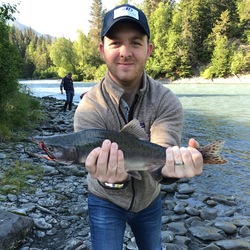Tidal Reverse
Château La Fleur de Boüard
Lalande de Pomerol Red Bordeaux Blend 2005
Clarendon Hills
Hickinbotham Syrah 2005
Popped and poured. No visual signs of age. Intoxicating aromas of dark berries, violets, and roasted meat in huge abundance. A tidal wave of pure dark berries and savory meats with remarkable texture. Structures for days. Hard to believe this is 12 years old...feels like it could age gracefully for 30-40 years. — 8 years ago
Benjamin Bridge
Tidal Bay
My absolute favorite white wine! Delish!
— 9 years ago
Palmaz Vineyards
Napa Valley Cabernet Sauvignon 2007
Imagine Grape Ape getting washed over by a plumb tidal wave and you will be close. In my case he was surfing on a 12pz bone on filet. Not enough marble to keep this beast afloat but the truffle butter was enough to do the trick. Bring the marble to this party and be sure to save a bite so as not to be left alone in the later rounds. If you are down for a fruit bomb battle royal then you have arrived. — 10 years ago

Domaine Sebastien Dampt
"Les Vaillons" Chablis 1er Cru Chardonnay 2013
While the Lechet is more seashell/tidal wave, the Vaillons is more spicey, exotic and perfumed. Terrific confectionary sugar on green apple really leap out of the glass. Bitter lime. Very aromatic. Palate is layered, deep and complex with nice finishing and structuring acidity throughout. Nice fruit pith on the finish. Terrific. — 10 years ago
Jacques Selosse
Initial Brut Blanc de Blancs Grand Cru Champagne Chardonnay
La Caña
Rías Baixas Albariño 2012
Reverse label of la Cana — 12 years ago
Domaine de Grand Pré
Tidal Bay Annapolis White Blend
One of several excellent white wines from Nova Scotia's newly designated Tidal Bay Region. A distinctive fresh taste combined with a slightly fruity nose make this one, one of the best in the province. — 12 years ago
Relic Wines
Ritual Napa Valley Mourvedre Blend 2013
Served from Coravin. I can see why the average CT for these wines hovers around a 91. This wine seems to drink in 'reverse.' Has a powerful purple and black fruit opening, but then really thins out quite a bit to a sweeter purple fruit and fig-rich finish. Definitely not a bad wine. Almost wondering if I didn't open this one too early, but not so sure as this one sort of has somewhat of a tart fruit finish. Not that it wasn't an enjoyable tart finish, but not what I was expecting. Just seemed to be all over the place. Would I kick this one out of bed for eating crackers? Naa....I'd probably eat a few myself. I think this wine showed better at the winery. If you have these, I really can't tell you whether or not I'd drink or hold....a little confused by this one! Might be worth popping the cork on the remaining half of the bottle, re-corking in an hour and coming back to the remainder tomorrow! — 7 years ago
Weingut Darting
Spätburgunder Trocken 2006
This. 2008 was amazing. Butterscotch and vanilla with great acidity and serious fruit. I wouldn’t be able to tell what this wine was if I was blind tasting and that was really really cool. Like a reverse orange wine. — 8 years ago
Cantine Barbera
La Bambina
Strong aromas of tidal pools, orange peel, citrus, watermelon, white fruit, and unripe strawberries. Tastes like strawberries grown near the sea. One of my favorite roses. — 8 years ago
Ceritas
Porter-Bass Vineyard Chardonnay 2010
Reverse mullet. See below. Not my photo — 8 years ago
Benjamin Bridge
Vero Tidal Bay White Blend
Nova Scotia terroir. Zesty lemon on the nose. Crisp, slightly off-dry with subtle minerality. — 9 years ago
Analemma
Columbia Gorge Atavus Pinot Noir Rosé 2013
Super cheesy and savory and perfect with triple cream cheese. Very little fruit on the nose...some currant in the reverse olfactory — 10 years ago
Giovanni Manzone
Il Crutin Langhe Nebbiolo 2012
summer, 2006, mid-sentence, tidal, we laughed about it after, but thoughts were escaping, tender red, the streetlight hinted sweet, but we held eachother close, chilled breeze marched on, our hoodies steadfast — 10 years ago
Pietranera
Brunello di Montalcino Sangiovese 2006
Tsssssss. Eating this with reverse ravioli carbonara, Jamon that eats truffles and chestnuts for a living AND filet mignon. Fantastic wine. This is what wine should be. — 10 years ago
Sjoeblom Winery
Cabernet Sauvignon Chauvignon Reserve Blanc de Noirs 2001
Very original. 100% Cabernet Sauvignon 2001 with 13 YEARS in sur lie. Lots of tropical fruit: pineapple, passion fruit; stone fruit: ripe peach; notes of ripe cherry, Granny Smith Apple, intense creamy mousse and creaminess. A delicate perlage and acidity with medium finish. Slightly sweet aftertaste. You can't compare it with a Pinot Noir or any another grape with traditional method. Normally in USA they tend to do the opposite for reds (judge Pinot noirs as cabs - big mistake). In this case (bubbles) is the reverse. — 11 years ago
Winery Arts
Seis al Reves - Reverse Six Tempranillo Merlot
Great with chicken — 11 years ago
Bryant Family Vineyard
Bettina Proprietary Cabernet Sauvignon Blend 2009
Yum Yum Yum. A tidal wave if fruit from the Git Go! No need to wait - pop the top and drink up! — 11 years ago
Petite Rivière
Tidal Bay Cotes de LaHave
Yet another excellent Tidal Bay wine from Nova Scotia. One of the best from the region, well-balanced, crisp with an amazing fruity nose. — 12 years ago
Domaine de Grand Pré
Tidal Bay Annapolis Valley 2015
A couple of years ago when Nova Scotia wines made their debut here at the wine festival, I tasted a lot with mixed results and put away a few bottles. I opened this one not expecting too much, but it was amazingly refreshing alongside a plate of ravioli with a bacony tomato sauce. Tropical flavors. Full of life. — 7 years ago
Bodegas Pagos de Mogar
Roble Ribera del Duero Tempranillo
Indeed a tidal wave of flavours and easy to read too much into this wine the smaller of the family. Well worth the money but owing to the complexity yet well balanced oak I am not sure if I‘d go for the bigger brothers from this vineyard. — 7 years ago
Tidal Bay
Nova Scotia White Wine 2017
Gaspereau Vineyards May 2018 Lobster supper with Cathy and Brad. Fantastic! — 8 years ago
Château Brane-Cantenac
Grand Cru Classé en 1855 Margaux Red Bordeaux Blend 2005
I have a six-pack of this 05. I thought after 10 years in bottle, it would be interesting to check in on its evolution. While tasty, I’ll wait another 8-10 to open another. Even after 2-3 hours in the decanter, it’s still a very young adolescent. On the nose, slightly sour blackberries & dark cherries, dark currants, baked black plum, haunting blue fruits, anise, whiff of spice, steeped tea, dry stones, dry crushed rocks with dry top soil, caramel, vanilla with fresh & dry red florals. The body is thick & full. Tannins are starting to round out. It’s velvety on the palate. The fruits are; bright, fresh & ripe and really show the greatness of the 05 vintage. Dark currants, blackberries, dark cherries, baked black plum, haunting blue fruits, baked strawberries, cherries, raspberries on the long set, dark spice, clay & loamy dry top soil with crushed rocks, dry stones, cigar with ash, graphite, dry stems, slight herbaceous character, mint, used leather, clove, caramel, vanilla, fresh & dry red florals with violets. The round acidity is about perfect. The structure and length are still strong. The balance is in harmony. As for the long finish, it’s lush, ruby, rich and well polished. Photos of; Chateau Brane Cantenac, large wood vats, Henri Lurton and Estate vines. Producer notes and history...Chateau Brane Cantenac began in the early 17th century. At the time, the estate was known as Domaine Guilhem Hosten. Even that far back, wine was produced from the property. In fact, the wine was so highly regarded it was one of the more expensive wines in Bordeaux. It sold for almost as much money as Brane Mouton. This is interesting because of who went on to buy the vineyard in the 1800’s. The Baron of Brane, also known as “Napoleon of the Vineyards”, purchased the Chateau in 1833. At the time of the sale, the estate was called Chateau Gorce-Guy. To get the funds needed to purchase the Margaux vineyard, the Baron sold what is now called Mouton Rothschild, which was at the time of the sale, known as Chateau Brane-Mouton. Not such a good move with hundreds of years in hindsight! In 1838, the Baron renamed property taking his name and the name of the sector where the vineyards were located and called it Chateau Brane Cantenac. The Chateau later passed to the Roy family, who were well-known in the Margaux appellation in those days, as they owned Chateau d’issan. Moving ahead to 1920, the Societe des Grands Crus de France, a group of merchants and growers that owned several chateaux located in the Medoc including; Chateau Margaux, Chateau Giscours, and Chateau Lagrange in St. Julien, purchased Chateau Brane Cantenac. Five years later, M. Recapet and his son-in-law, François Lurton, took over Brane Cantenac along with Chateau Margaux. Lucien Lurton (the son of François Lurton) inherited Brane Cantenac in 1956. Today, the estate is still in the hands of the Lurton family. Brane Cantenac is owned and run by Henri Lurton. After being given the responsibility of managing Brane Cantenac, it was under the direction of Henri Lurton that large portions of the vineyard were replanted. Vine densities were increased, the drainage systems were improved and the plantings were also, slowly changed. The vineyard of Brane Cantenac is planted to 55% Cabernet Sauvignon, 40% Merlot, 4.5% Cabernet Franc and .5% Carmenere. Carmenere was used for the first time in the 2011 vintage. The only other Chateau I know that still uses Carmenere is Clerc Milon. The 75 hectare Left Bank vineyard of Brane Cantenac is essentially unchanged since it earned Second Growth status in the 1855 Classification. At least that is the case with the 45 hectares used to produce the Grand Vin of Brane Cantenac. Those 45 hectares are planted surrounding the Chateau. Those vines are located just in front of the Cantenac plateau and are the best terroir that Brane Cantenac owns. They have other parcels, which are further inland and much of those grapes are placed into their second wine, Le Baron de Brane. Those additional hectares can be divided into 3 main sections. Behind the Chateau, they have 15 hectares of vines on gravel and sand, 10 hectares across the road with sand, gravel and iron and a 13 hectare parcel with gravel called Notton, which is used for their second wine. The vineyard is planted to a vine density that ranges from 6,666 vines per hectare on the plateau and up to 8,000 vines per hectare for the vines located behind chateau, in their sandier soils. The higher levels of vine density are always found in the newer plantings. The terroir of Brane Cantenac consists of deep gravel, sand and clay soil. Experiments in the vineyards are currently looking at becoming more organic in their vineyard management. Today, more than 25% of Brane Cantenac is farmed using organic farming techniques. It is expected that over time, the amount of hectares farmed with organic methods will be increased. Brane Cantenac has gone through 2 relatively recent modernization’s in 1999, when they added began adding the first of their smaller vats to allow for parcel by parcel vinification and then again in 2015 when they completed a much more complete renovation of their cellars and vat rooms. While Brane Cantenac is a traditional producer, they are no stranger to technology as they were one of the first estates to embrace optical grape sorting machines. In very wet vintages, they can also use reverse osmosis. To produce the wine of Chateau Brane Cantenac, the wine is vinified in a combination of temperature controlled, traditional, 22 oak vats, 18 concrete tanks and 20 stainless steel vats that vary in size from 40 hectoliters all the way up to 200 hectoliters, which allows for parcel by parcel vinification. 40% of the fermentation takes place in the oak vats. The oldest vines are vinified in vats that are selected to allow for separate parcel by parcel vinification. The younger vines are vinified more often together in the same vats. However, the Carmenere is entirely micro-vinified, meaning that those grapes were completely vinified in barrel, using micro-vinification techniques. This can also happen because the amount of grapes produced is so small. Some vats can be co-inoculated, meaning they go through alcoholic fermentation and malolactic fermentation simultaneously. At Chateau Brane Cantenac, malolactic fermentation takes place in a combination of French oak tanks and barrels. The wine of Brane Cantenac is aged in an average of 60% new, French oak barrels for 18 months before bottling. The initial 2 months of aging is done with the wine on its lees, which adds more depth to the wine. There second wine is Le Baron de Brane. Le Baron de Brane is not new. In fact, previously, the second wine went under the name of Chateau Notton, which took its name from one of the main parcels where the grapes were planted. During the late 1950’s and into the 1960’s, having a second wine was important as the estate declassified 3 vintages, due to extremely poor, weather conditions in 1956, 1960 and 1963. Production of Chateau Brane Cantenac is about 11,000 cases per year. — 8 years ago

Habit Wine Company
Jurassic Park Vineyard Chenin Blanc 2013
It was born as a heavy weight Jurassic indeed, tidal waves of flavor stoney fruit as hell, fresh young white peach pith, with clarified butter accents , quince paste texture, baked golden apple skins! Lemon chiffon cake dry backside, it lures me in paired well w/
Ahi , but might pair better with cake or lighter fish barramundi or tilefish — 11 years ago
Oakville Terraces
Oakville Cabernet Sauvignon 2008
Thirty minute decant. Wow. Opulent fruit: currants & plums come in a tidal wave. Tobacco and some spice box with a little green bell pepper. Finish lasts at least 30 seconds. Soft as velvet. Held up great over two days. Tremendous. — 11 years ago
Domaine du Vissoux / Pierre-Marie Chermette
Vignes Centenaires Coeur du Vendange Beaujolais Gamay 2012
the oldest vines in southern beaujolais. reverse mullet- fruit party in the front, black pepper business in the back. — 12 years ago
Jost Vineyards
Tidal Bay L'Acadie Blanc Blend 2012
Very yummy wine ... Tasted first at wine tasting with Dan :) — 12 years ago


























Somm David T
Independent Sommelier/Wine Educator
The nose reveals, dark currants, ripe, slightly liqueur; blackberries, black plum, dark cherries, black raspberries, charred strawberries, hints of cooked rhubarb and raspberries. Mixed berry licorice/cola, anise, vanilla, cinnamon, nutmeg, touch clove, steeped fruit tea, herbaceous notes, leather, tobacco, charcoal, wood shavings, limestone minerals, dry stones, a little forest floor, dark fresh florals, lavender & violets.
The body is round, lush with some dusty tannins on the long set. It’s really beautiful right now but, there is still better things ahead over the next 5-8 years before it peaks. It’s silky & satiny. The structure, length, tension and balance are really starting to hit its stride. Dark currants, ripe, slightly liqueur; blackberries, black plum, dark cherries, black raspberries, plum, charred strawberries, hints of cooked rhubarb and raspberries. Mixed berry licorice/cola, anise, vanilla, cinnamon, nutmeg, touch clove, mocha powder, medium dark spice, steeped fruit tea, herbaceous notes, mint, expresso roast, leather, cedar, limestone minerals, dry stones, crushed dry rock & clay, a little forest floor, dark fresh florals, lavender & violets. The acidity is round & beautiful...really shows the greatness of the vintage. The finish is; lush, rich, ripe, elegant, well balanced, polished and quite persistent.
Photos of, Chateau La Fleur de Bouard, the tops of the stainless steel tanks that flow by gravity into the tanks that hang from the other side of the floor/ceiling and their Merlot vines.
I think this was under $35 when I bought it in futures.
Producer history & notes...Chateau La Fleur de Bouard was started by Hubert de Bouard, the owner of Chateau Angelus and Chateau Bellevue in St. Emilion. Hubert de Bouard purchased the vineyard from in 1998. This is a relatively new wine, as the first year for the wine was produced with the 2000 vintage.
Chateau La Fleur de Bouard is produced from a specific a two hectare parcel of old vines that are around 45 years of age, situated on the Lalande de Pomerol Plateau. The vineyard for Chateau La Fleur de Bouard Le Plus is planted to 100% old vine Merlot.
In 2011, La Fleur de Bouard completed a multi-year, top to bottom reconstruction of their entire wine making making facilities and the chateau, making this one of the most modern estates in the Right Bank. The most striking new feature is their hanging, reverse, conical, stainless steel vats as shown in my photos.
The production of La Fleur de Bouard sees a five day cold soak at 10 degrees Celsius and a four-week maceration in “OVNI” stainless steel tanks. The wine is vinified in a combination of stainless steel vats and short, squat shaped oak barrels. The wine receives regular pigeages.
Malolactic fermentation takes place in 100% new, French oak barrels from four different coopers, Taransaud (40%), Demptos (40%), Darnajou (15%) and Vicard (5%). Aging sur lies takes place in 100% new, French oak barrels for an estimated 33 months prior to bottling. The wine requires collaring time for the oak to fully integrate into the wine, and for the secondary notes to develop. — 7 years ago